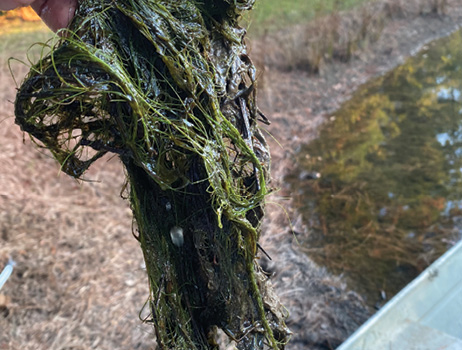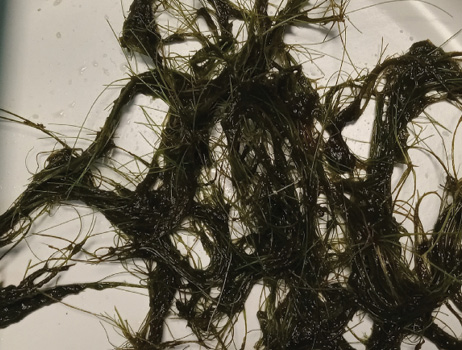Slender Spikerush | Eleocharis spp.
Submersed | Native

that has been pulled from a pond.


There are several species of spikerush that can occur in Mississippi waters. Some species grow on the water margins as emergent plants, similar in appearance to other rushes and sedges. However, the submersed version that commonly causes problems in ponds is the fully aquatic, free-floating growth form.
Although the two growth forms can co-occur, they often are found separately. Do not use one as a diagnostic for the other.
The submersed form that is commonly found, E. vivipara, is a tangle of long, thin branches. This hair-like appearance gives it the common name “hair-grass.”
The submersed growth form is viviparous, meaning that new plants grow directly from the submersed spikelets. For this reason, slender spikerush can grow in dense mats very quickly and take over water bodies.
Management Value
Slender spikerush is a native plant, and its seeds, leaves, and rhizomes are eaten by some species of waterfowl and possibly other wildlife. While it does provide habitat for fish, it is highly invasive and usually takes over. Slender spikerush is not recommended for pond management.
Recommended Controls
Option 1: Diquat (3.73-pound formulation). Diquat (0.5 gallon per acre-foot of water) should be applied as a submersed injection (application using a wand or hose). Determine pond volume prior to application. Do not exceed annual herbicide rate limits as stated on the product label.
NOTE: Acre-foot = average depth of pond multiplied by pond acreage; average depth is calculated by taking the depth at 20 points across a water body and averaging the values.
Option 2: Triploid Grass Carp. Stock 5 to 10 grass carp per acre to reduce moderate pondweed infestations; stock 15 or more per acre for severe infestations. Note that abundant grass carp can impact other fish and can survive 20 years.
Stock 8- to 10-inch triploid grass carp in ponds that have established largemouth bass populations.
Treat ponds when the plants are actively growing and the water temperature is at least 60˚F. It would be best to treat one-third of the pond at a time for larger water bodies, with 2 weeks or more separating applications. After the entire pond has been treated, a repeat whole-pond application may be needed to eliminate remaining plants.
Read and follow all chemical label instructions, especially the section on the use of personal protection equipment.
Photo Credits Middle: D. Waldrop

The information given here is for educational purposes only. References to commercial products, trade names, or suppliers are made with the understanding that no endorsement is implied and that no discrimination against other products or suppliers is intended.
Publication 3735-11 (POD-11-23)
By Wes Neal, PhD, Extension/Research Professor, Wildlife, Fisheries, and Aquaculture; Dennis Riecke, Fisheries Coordinator, Mississippi Department of Wildlife, Fisheries, and Parks; and Gray Turnage, PhD, Assistant Research/Extension Professor, GeoSystems Research Institute.
The Mississippi State University Extension Service is working to ensure all web content is accessible to all users. If you need assistance accessing any of our content, please email the webteam or call 662-325-2262.



